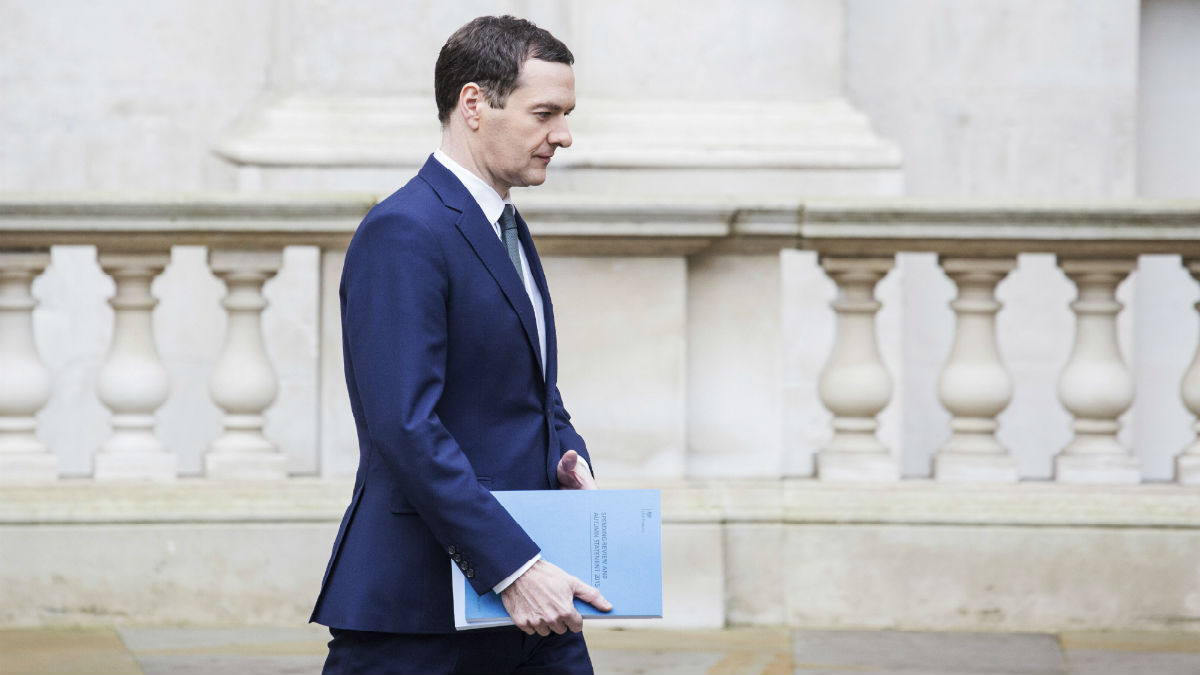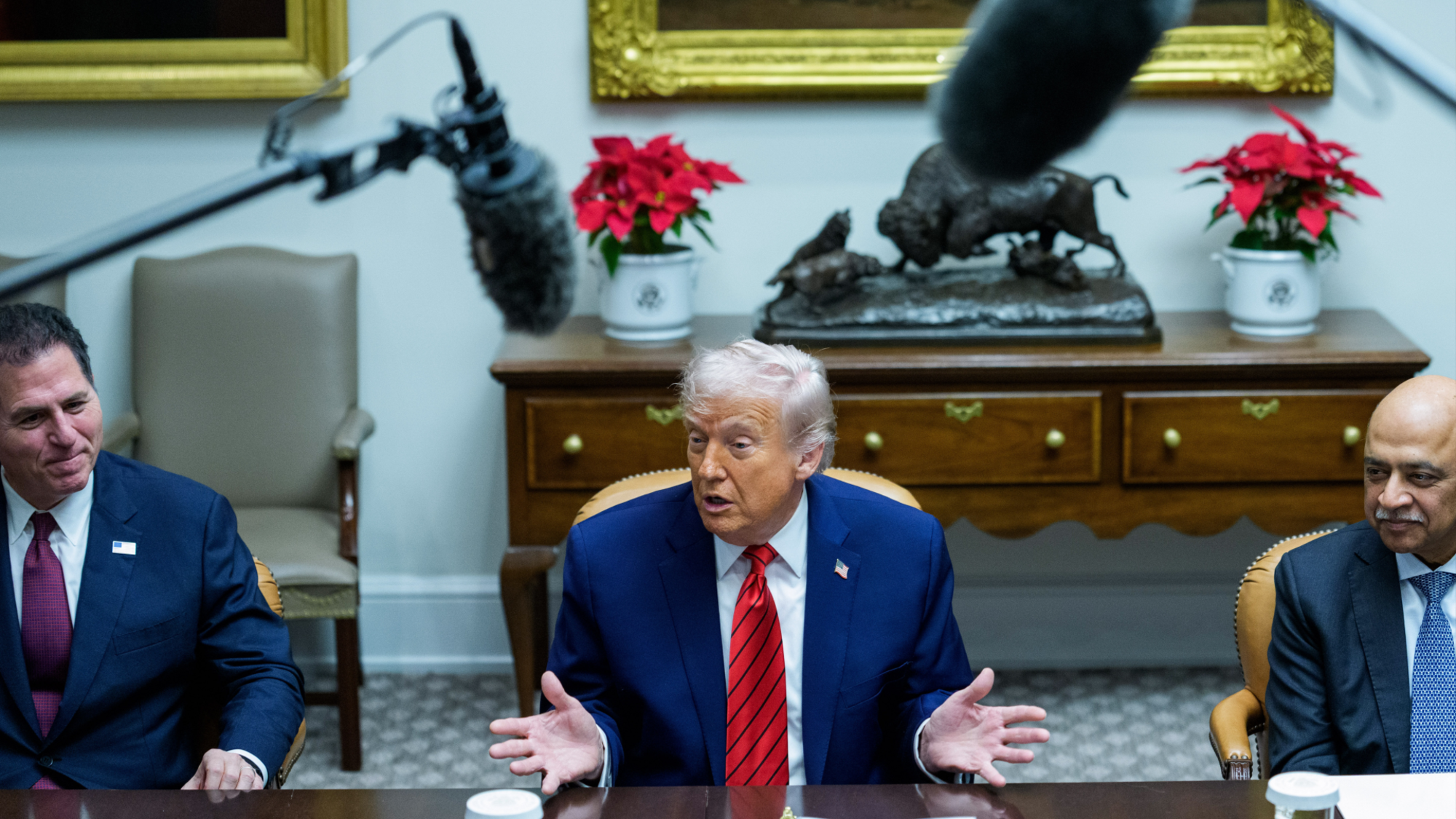Autumn Statement 2015: who will win and who will lose?
Unchanged Universal Credit will reduce 'long-term generosity' of benefits, but poorer families are more protected

Autumn Statement 2015: borrowing jump squeezes 'wiggle room'
20 November
George Osborne's ability to soften cuts to tax credits and ease the pressure on key security budgets has been restricted, after the worst government borrowing figures for six years were recorded in October.
Official figures show government borrowing, the debt taken on to cover the difference between tax receipts and spending, was £8.2bn last month. This is £1.1bn higher than October 2014 and the worst figure for the month since 2009, the BBC says.
The Week
Escape your echo chamber. Get the facts behind the news, plus analysis from multiple perspectives.

Sign up for The Week's Free Newsletters
From our morning news briefing to a weekly Good News Newsletter, get the best of The Week delivered directly to your inbox.
From our morning news briefing to a weekly Good News Newsletter, get the best of The Week delivered directly to your inbox.
Chris Giles writes in the Financial Times that "October is an important month for the public finances because quarterly corporation tax payments are made in the month". However, he said the data show "tax receipts from companies, incomes and [consumer] spending were lower than needed to meet the government's targets".
Total tax receipts were 1.8 per cent down last month compared with a year earlier. In the first seven months of the year they have risen by 3 per cent, compared to a forecast for revenue growth from the Office for Budget Responsibility of 4.1 per cent for the year as a whole.
With borrowing for this year now having reached £54.3bn, the Chancellor would have to keep the aggregate total for the five months between now and next April to a little more £15bn to meet his £69.5bn full-year target. Borrowing will still undershoot 2014, when the annual total was £90bn.
While January typically provides a surplus from self-assessment tax returns, commentators reckon Osborne will only achieve his target if he makes deeper cuts in next week's Autumn Statement. Missing the 2015 number would put the longer-term plan of reaching a budget surplus by 2019/2020 in doubt.
A free daily email with the biggest news stories of the day – and the best features from TheWeek.com
What might he do?
Osborne is also under pressure to find extra funds, which could add further to borrowing.
He has pledged to soften the blow of tax credits cuts in the years up to 2020, when the new national living wage is introduced in full, as well as to fund £100bn of infrastructure projects over five years.
In the wake of the Paris terrorist atrocities, there are also loud calls to minimise cuts at the Home Office budget in order to ensure that front-line policing is not affected. The department is one of nine that have not yet agreed a cuts target for the spending review (see below).
The Daily Telegraph says some mitigating measures to ease the squeeze could include a fresh clampdown on tax avoidance, or an increase in diesel fuel duties in the wake of the global emissions scandal.
Of more help could be low interest rates, which could substantially reduce debt servicing costs in the coming years. In addition to the £10bn of 'wiggle room' the Chancellor had already afforded himself by 2020, this might provide a boost that helps to balance the books.
Autumn Statement 2015: Osborne still a long way from cuts target
17 November
With just over a week to go until the Autumn Statement – the third package of financial policy measures this year – George Osborne is getting on with the business of securing the cuts promised at the election.
Seven more Whitehall departments and nine government bodies have reached agreement with the Chancellor on cuts totalling 21 per cent of their day-to-day spending by the 2019/2020 financial year. The Guardian reports that the deals equate to reductions of around six per cent a year from now.
This takes the number of departments that have agreed cuts to 11 out of the total of 20, with aggregate savings totalling 24 per cent a year by the end of the period.
Last week the departments for transport, local government and environment, as well as the Treasury itself, committed to cuts of 30 per cent by 2020. Included in the new batch of deals are HM Revenue & Customs, the Cabinet Office, the offices for Scotland, Wales and Northern Ireland, and the departments of energy and climate change and work and pensions.
This latter is key. Osborne was said to have been locked in a bitter dispute with Work and Pensions Secretary Iain Duncan Smith over the cuts to his department. Measure for softening cuts to working tax credits, rejected by the House of Lords last month, were a particular sore point.
A long way to go
The cuts agreed thus far cover only running costs – otherwise known as the 'departmental expenditure limit'. In the case of the DWP this includes the costs of staffing job centres, for example, but does not include the cuts to tax credits, which as part of the welfare bill are included with the larger 'annually managed expenditure' budget.
Osborne has promised to soften the tax credit cuts with "transitional protections", but what this means and whether any claimants will still be left out of pocket will not be known until the Autumn Statement is announced on the 25 November
In total the cuts agreed so far equate to around £4bn of annual costs, the Financial Times says, only a fifth of the £20bn of savings in government spending the Conservatives pledged at the election. This means there are some big numbers still to come – and some big departments, including the Home Office and Foreign Office, still locked in negotiations
Some had even suggested that cuts may go further than originally intended to provide additional funds for the £100bn of infrastructure spending pledged by Osborne. Instead, he may be offered a lifeline by reduced bill to service government debt as low interest rates persist.
That may offer enough wiggle room to meet a promise for a budget surplus by the end of this parliament.
Autumn Statement 2015: which public assets might be privatised?
13 November
As part of its drive to reduce the UK's massive debt pile, the government has raised billions through sales of the country's assets.
Hailed by small-state Conservatives as a way to inject dynamism into sclerotic industries – and derided by opponents as a fire sale of the family silver – a number of sales have already taken place. They began under the coalition, and have continued in the first months of David Cameron's second term.
So far good progress has been made with the profitable sale of Lloyds Banking Group, as well as the very unprofitable sale of the Royal Bank of Scotland. The sell-offs of Royal Mail and Eurostar were completed earlier this year, while the disposal of a £13bn portfolio of mortgages that used to belong to Northern Rock was announced this morning.
But with pledges to fund £100bn worth of infrastructure projects over the next five years (see below), while cutting departmental budgets, more privatisation activity is bound to follow. So what could be on the chopping block?
Housing associations
Strictly speaking, housing associations are private, not-for-profit organisations, often set up as independent charities. But they operate within a legislative framework set by the government – which forces them, for example, to sell houses at a discount under a revamped 'right to buy' scheme – and the statistics watchdog recently decided that as they've received hefty grants they should be counted as public sector bodies.
The move brought about £60bn a year of private debt on to the government's balance sheet, increasing public sector borrowing figures. But the Financial Times says it could also be a "boon" for George Osborne, as it enables him to make a case for de-regulating and selling the £40bn in no-interest loans it provided to build homes.
There are plenty of questions about how this would work: not least of which is who would want to buy loans that pay no interest, and what discount would they would want. The FT's Jonathan Guthrie also questions how the government would make up the shortfall in social housing, as turnover of these credit lines when houses are sold generates money to invest in new properties.
Network Rail
It won't happen at the spending review this month, but an interim report into Network Rail, the underperforming body that controls UK rail infrastructure and is responsible for £38bn of upgrade works, has left open the possibility of a full privatisation to reduce debt and improve efficiency.
The Times says alternative options include "stripping Network Rail of control of railway stations and selling assets". It could also be "broken up into a series of smaller companies, with separate groups taking responsibility for the maintenance and upgrade of intercity and local commuter lines", the paper says.
Any sale of Network Rail would be controversial given Labour's stated desire to renationalise the railways, but there is little argument that Network Rail needs urgent reform: it is behind on projects and has been responsible for a series of calamities. Its own chief executive has previously admitted it has too wide a remit.
Channel Four
A sale of the state-owned broadcaster is also being considered, David Cameron has acknowledged. He says the government is open to all options to "safeguard" the future of Channel Four, which operates as a public service broadcaster but raises its own funding through advertising.
The £1bn mooted price tag would be useful for the Department of Media, Culture and Sport – an unprotected department likely to be facing a severe cut in the next spending round.
We're probably some way from this actually happening, however, and there is plenty of opposition to the move. How it plays could depend on who was being lined up as a buyer. If it was a UK broadcaster like BT or, as some suggest, a Royal Mail-style sale to the public, it might begin to be seen more favourably.
Anything else?
Almost certainly. Expect more land and building sales from various departments to meet cuts targets, while options under discussion have included the sale of the student loan book. One that won't happen is the £500m sale of the body that collects court fines, which The Independent says was dropped this month.
Autumn Statement 2015: will Osborne soften pace of cuts?
9 November
Chancellor George Osborne may agree to scale back cuts to government spending, including easing back on planned restrictions to working tax credits.
Ahead of a major 'spending review' later this month that the Tories pledged at the election would see £20bn a year cut from departmental budgets, the Financial Times says there is acknowledgement in Whitehall that lower interest rates are reducing the cost of servicing government debt.
Sources reckon that lower rates on gilts will save £4bn a year compared to previous Office for Budget Responsibility projections, with around half of this being offset by lower equity values and thus capital gains tax take. There are also other associated costs of lower rates, such as shortfalls against pension savings and potentially higher housing benefit costs as rents rise.
The net savings could enable Osborne to make concessions on the controversial cuts to working tax credits, which were sensationally rejected by the House of Lords last month.
Originally pencilled in to save more than £4bn a year, the chancellor has promised "transitional support" to tax credit claimants who will lose out before the full effects of a higher minimum wage are felt over the next five years. Other low paid workers, such as those on part-time hours, could still lose out overall and the government is under pressure to offer help.
There had been suggestions that the plan to cut £12bn from the annual welfare bill could be put back on track by cutting incentives offered through universal credit, which will ultimately replace six benefits including both working and child tax credits. But work and pensions secretary Iain Duncan Smith is said to be rejecting the proposals and is even prepared to resign over the issue.
Savings already agreed
Some departments have already agreed their annual budget reductions, Osborne will announce today. The BBC says the Treasury, transport, local government and environment departments have all agreed to cut around eight per cent each year from spending in order to save a total of 30 per cent by 2020. Osborne had asked departments to show how they would make cuts of between 25 and 40 per cent.
Announcing the agreed deals is aimed at increasing "pressure on ministers who are still resisting his demands for cuts in their departments", says The Guardian. Theresa May and Philip Hammond, home and defence secretaries respectively, are among those who are holding out amid concern over the impact of cuts to their budgets.
Any excess savings made in non-ringfenced areas, or debt savings not allocated to prop up the tax credit bill, could be used to ease cuts in other critical areas, but competition for residual funding is intense. In addition to ministries fighting to retain their own budgets, Osborne announced last month that as much as £100bn will be allocated over the next five years to infrastructure spending (see below).
-
 What role will Trump play in the battle over Warner Bros. Discovery?
What role will Trump play in the battle over Warner Bros. Discovery?Today’s Big Question Netflix and Paramount fight for the president’s approval
-
 ‘The menu’s other highlights smack of the surreal’
‘The menu’s other highlights smack of the surreal’Instant Opinion Opinion, comment and editorials of the day
-
 Education: More Americans say college isn’t worth it
Education: More Americans say college isn’t worth itfeature College is costly and job prospects are vanishing